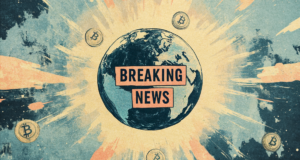What Are Prediction Markets and How Do They Work

For centuries, people have sought to predict the future, from military strategy to seasonal forecasts and personal fates. Betting companies turned that instinct into a profitable business, and now, their models have transitioned to the blockchain.
On this page
- What Sets Traditional Betting Apart from Prediction Markets
- The Importance of Prediction Markets and Their Real-World Impact
- Advocates of Prediction Markets
- Prediction Markets: Their Evolution and Varieties
- Augur — Blockchain’s First Prediction Market
- Polymarket — A Catalyst for Blockchain Betting
- Prediction Markets: Future Outlook
Prediction markets function as platforms that allow individuals to wager on the likelihood of specific future events. Users predict whether a certain outcome will occur by placing bets on the relevant scenario. The market’s pricing follows a supply and demand model, with the cost of a bet reflecting the perceived probability of the event.
As the event’s likelihood increases, the value of the asset tied to the positive result also rises.
Price fluctuations in the Trump vs. Harris presidential election. Source: polymarket.com
The mechanism behind prediction markets is akin to futures trading, where agreements are made to buy or sell assets at a specific price on a future date.
In prediction markets, instead of physical goods or financial products, users trade “shares of probability” on future events. If the event unfolds as expected, those who bet on the right outcome collect their investment and profit; if not, they lose their money, which then fund the winners’ pool.
Participants essentially trade probabilities, buying or selling positions on different events. Unlike traditional markets where oil or stocks are traded, prediction markets revolve around outcomes like elections, sports results, or even asteroid strikes.
On these platforms, one can wager on a variety of outcomes, including:
- Political events: election results, wars won or lost, legislative achievements, major resignations;
- Economic indicators: GDP growth or contraction, shifts in interest rates, economic slowdowns or recoveries;
- Sports events: championship victories, major athletic awards, headline transfers;
- Public or cultural events: product launches, remakes, film content revelations.
Today, prediction markets offer more than just bets—they’ve become a tool for “crowd-sourced forecasting,” where event probabilities are heavily influenced by participants’ estimations of possible outcomes.
What Sets Traditional Betting Apart from Prediction Markets
Although both traditional betting and prediction markets let individuals wager on outcomes, they are fundamentally different in terms of purpose, mechanics, and structure.
Motivations and Goals of Participants
Traditional betting is all about profit. Participants place bets on events like sports matches, where bookmakers set odds based on probability. If the bettor’s prediction is correct, they win; if not, they lose. The main motivation is often the excitement of the bet and the chance to win money.
Prediction markets, however, appeal to those who not only want to earn but also engage in a collective evaluation of event probabilities. The prices of contracts or bets reflect the collective sentiment of participants about the likelihood of outcomes, turning these markets into tools for gathering data and insights about future events.
Transparency and Liquidity
In traditional betting, bookmakers set the odds, and bettors have little say in how those odds shift. This reliance on a third party creates limitations. Scandals like athletes influencing bets or match-fixing, where a team may intentionally lose after high-stakes bets, have brought attention to these practices.
Prediction markets, in contrast, operate transparently, with the market price shaped by participant activity. Odds change according to the balance of bets placed.
Moreover, traditional betting is frequently subject to stringent gambling regulations, particularly in regions where gambling is restricted or banned.
Prediction markets benefit from greater liquidity — participants can not only place bets but also trade contracts prior to the outcome, similar to stock trading. This provides the ability to shift positions as new information arises, offering more flexibility than traditional betting systems. The nature of this mechanism allows for more accurate collective forecasting and analysis.
The Importance of Prediction Markets and Their Real-World Impact
Prediction markets offer a space where collective intelligence helps determine the likelihood of future events. They're not just a form of betting or amusement—these markets can have significant real-world implications by helping individuals and organizations make informed decisions.
For example, during the 2008 U.S. presidential race, traditional polling struggled to provide consistent results, but prediction markets like Intrade outperformed them by more accurately gauging Barack Obama’s victory odds.
DARPA FutureMap
The FutureMap project, developed by DARPA in the early 2000s, is a well-known example of prediction markets in practice. The project’s objective was to use prediction markets to forecast the probabilities of security-related events, including terrorism and international crises.
Participants placed bets on these outcomes, and the aggregated data was used to generate more precise predictions. Though FutureMap attracted criticism and was ultimately canceled, it showcased the potential of prediction markets for enhancing risk analysis and informing government-level decisions.
Advocates of Prediction Markets
Robin D. Hanson, an influential economist and the mind behind the theory of “futarchy,” is one of the most vocal advocates of prediction markets. He believes that these markets can sharpen the accuracy of forecasts by pooling data and insights from a wide audience.
Hanson’s concept of information markets shows that asset prices can reflect the shared opinion on the probability of future events.
By considering Hanson’s reasoning, the benefits of prediction markets come into focus, especially their capacity to:
- Leverage collective wisdom: Hanson believes that prediction markets are more reliable than individual experts because they pool the knowledge of a wide range of participants. Similar to stock markets, prices reflect the collective outlook of those involved.
- Maintain objectivity: In contrast to expert forecasts, which can be swayed by personal bias, prediction markets are fact-driven. Participants are incentivized to make accurate predictions for financial reward.
- Efficiently process information: Hanson points out that these markets are quick to incorporate new information, updating their predictions as data changes, which makes them highly efficient for tracking event probabilities.
This belief is shared by Justin Wolfers, a professor of economics, and Paul Slovic, a psychologist, who claims that prediction markets help minimize cognitive biases in forecasting.
Prediction Markets: Their Evolution and Varieties
The idea of prediction markets took shape in the 1980s, with scientists exploring the potential of market systems to predict the future. In 1988, the Foresight Exchange was born as one of the first platforms where participants could bet on future outcomes.
In 1993, the U.S. government sponsored the Policy Analysis Market (PAM), which sought to use prediction markets to predict political or terrorist risks. Despite the project's innovative approach, it faced public outcry over ethical concerns and was ultimately shut down.
By 2003, the Iowa Electronic Markets had gained prominence as one of the first commercial markets dedicated to election forecasting, earning recognition for its accuracy and becoming a template for similar markets in the years to come.
In 2014, the market saw the launch of Augur, the first decentralized prediction market built on blockchain technology. Augur leveraged smart contracts to create transparent and secure markets, allowing users to bet on any event. However, technical difficulties and liquidity issues limited the platform’s success.
By 2024, Polymarket reignited interest in blockchain-based prediction markets. With a user-friendly interface and the ability to bet on current events like elections and sports, Polymarket drew significant attention to the space, proving that prediction markets could thrive in a decentralized environment.
As platforms matured and new ones were introduced, a broader range of prediction markets began to take shape.
Continuous Double Auction (CDA). As the most frequently employed model in prediction markets, CDA lets participants make buy and sell offers simultaneously. Real-time market prices are set by supply-demand dynamics, offering high liquidity and giving traders the ability to respond swiftly to changing information.
Automated Market Makers (AMM). Unlike CDA, AMM systems automate the process, eliminating the need for active participants to execute trades. Prices are determined by algorithms using predefined formulas, allowing users to trade contracts without waiting for another party to step in.
Play Money Markets. These markets give participants the chance to bet with virtual money, offering a low-risk way to explore prediction market dynamics. Used primarily in educational contexts, Play Money Markets help individuals learn and experiment with market behavior without financial stakes.
Blockchain-Based Prediction Markets. Built on blockchain technology, these platforms offer a decentralized and transparent way to place bets on future events. Results are recorded on the blockchain, ensuring security and transparency. Platforms like Augur and Polymarket demonstrate how blockchain can build trust by safeguarding the integrity of bets and outcomes.
Augur — Blockchain’s First Prediction Market
In 2015, Augur broke new ground as the first decentralized prediction market on the Ethereum blockchain. Through smart contracts, it enables users to make bets on a wide array of event outcomes. Additionally, Augur’s unique ability to let users create markets boosts the range of available predictions.
Augur raised $5.3 million during its ICO in 2015 and issued REP (Reputation) tokens. These tokens are integral to the platform’s governance, required for voting on the outcomes of predicted events.
ICO details and the project’s investor list. Source: icodrops.com
The Augur platform fell short of expectations for several reasons:
- Complicated interface: The platform’s complexity made it inaccessible for the average user.
- Low liquidity: With fewer active users, the markets lacked liquidity, reducing the attractiveness of placing bets.
- Stiff competition: Platforms like Polymarket, which were simpler and more popular, drew users away.
- Regulatory hurdles: Legal issues surrounding gambling laws slowed down Augur’s growth.
In 2016, Augur was thrust into the spotlight for allowing users to bet on violent outcomes, including the assassinations of public figures. This led to significant backlash, with concerns about the platform’s ethical and legal implications.
Polymarket — A Catalyst for Blockchain Betting
Polymarket, a decentralized platform launched on Ethereum in 2020, has ignited widespread interest in blockchain-based prediction markets. It allows users to bet on the probability of events ranging from political outcomes to economic performance and social trends.
Polymarket’s popularity is fueled by a number of significant factors:
- The 2024 U.S. Presidential Election — The election brought widespread attention to the platform, with bettors actively wagering on the results. Donald Trump himself mentioned Polymarket, and its dashboards tracking bets appeared frequently on major U.S. news broadcasts, which increased the platform’s liquidity and public interest.
- Betting on Ethereum and Bitcoin ETF Approval — Discussions around Bitcoin and Ethereum ETFs sparked a surge in bets on Polymarket, as users wagered on whether these ETFs would be approved, driving further engagement on the platform.
Moreover, Polymarket simplified the user experience, making it easier for visitors from traditional betting sites to join in. To place a bet, users just need to fund their cryptocurrency wallets and connect them within a few clicks.
The platform functions on an order book model, enabling users to bet on different event outcomes. They can place buy or sell orders, and prices are updated in real-time based on the activity on the platform, fostering a dynamic trading environment.
Since its debut, Polymarket has made substantial strides. In October 2024, it reached a milestone with its total trade volume exceeding $1 billion.
Polymarket's monthly trade volumes. Source:dune.com
Polymarket’s monthly active user count has surpassed 100,000, further indicating the rising popularity of decentralized prediction markets.
What's important to note is that Polymarket is also helping to boost the mass adoption of cryptocurrencies. Entertainment—be it gaming or betting—has consistently been a key method of introducing people to emerging technologies, as was the case with the rise of the internet, personal computers, and now blockchain.
In addition to GameFi projects and tap-to-earn apps like Notcoin and Hamster Kombat, gambling could significantly fuel crypto interest. Bettors from traditional platforms are likely to transition to blockchain thanks to better betting choices and higher payment guarantees.
Prediction Markets: Future Outlook
Prediction markets are poised for a promising future, fueled by technology and the evolving public perception of gambling.
Decentralized platforms like Polymarket and Augur are rapidly growing, offering users a way to bet without strict regulatory frameworks. This opens the doors to broader participation and democratizes the betting process.
As more participants enter the scene and trade volumes grow, prediction markets could emerge as powerful tools for analysis and forecasting. Governments and businesses might use these platforms to predict the likelihood of various events, from financial crises to natural disasters. Data from the betting markets would provide insights into public expectations, which could ultimately help inform smarter decision-making.
As the cryptocurrency and blockchain sectors expand, new projects and platforms with enhanced functionality and more intuitive interfaces are likely to emerge. This influx of competition could improve liquidity and make predictions more accurate.
On the flip side, prediction markets could face regulatory challenges. Governments might aim to impose more control, which could stifle their growth.
Still, if prediction markets can prove their value and reliability, they have the potential to become key players in the economy, creating fresh pathways for investment and forecasting. Their future will be shaped by technological advancements and regulatory frameworks.
The content on The Coinomist is for informational purposes only and should not be interpreted as financial advice. While we strive to provide accurate and up-to-date information, we do not guarantee the accuracy, completeness, or reliability of any content. Neither we accept liability for any errors or omissions in the information provided or for any financial losses incurred as a result of relying on this information. Actions based on this content are at your own risk. Always do your own research and consult a professional. See our Terms, Privacy Policy, and Disclaimers for more details.




























